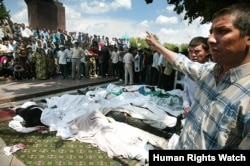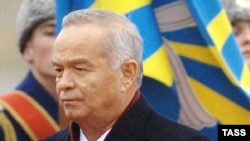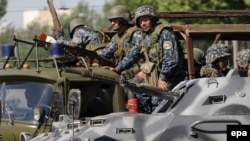
On May 13, 2005, the Uzbek military and security forces put down a revolt in the eastern city of Andijon by using deadly and indiscriminate force. Hundreds and possibly more than 1,000 people were shot dead in just a few hours.
The event has been characterized as a massacre, and for the past 10 years the Uzbek government has ignored international criticism of its handling of the crisis.
RFE/RL's Bruce Pannier spoke with Steve Swerdlow, the Central Asian researcher at Human Rights Watch, about the rights situation in Uzbekistan before and after Andijon, including the Uzbek authorities' attempts to create a new narrative for Andijon, and also the fate of some of the people alleged to have been involved in the unrest.
RFE/RL: Could you explain what the rights situation was like in Uzbekistan prior to May 2005, when Andijon happened?
Steve Swerdlow: Uzbekistan has a very abysmal, one could say, human rights record. Even before Andijon, the government had systematically eliminated the opposition, had gone after human rights defenders, and starting in about 1998 with the passage of one of the world's most restrictive laws on religion, the government imprisoned thousands -- both imprisoned, tortured, arbitrarily detained -- thousands of what we refer to as independent Muslims and sentenced them to very lengthy terms.
READ MORE: Andijon -- What Happened And Why
Independent Muslims are people that practice their belief or their religion outside of the strict state controls that the Uzbek authorities established, which could mean praying in your home, it could mean carrying an unauthorized piece of literature such as a Koran, or wearing a beard or a hijab in the wrong place.
And so really you had a very serious human rights situation in Uzbekistan, but at the same time there was some momentum even on the part of the government a few years before Andijon where one could see that Tashkent was at specific moments maybe looking for areas that it could engage on human rights issues.
So in 2002, for example, they did allow the one and only, last visit by a UN human rights expert, the special rapporteur on torture, who was allowed to visit Uzbekistan and do a comprehensive examination of the situation regarding torture and the criminal justice system. And there was also in 2002, the registration -- also the one and only -- of an NGO, an independent human rights group called Ezgulik.
So there were a few bright spots, one could say, amidst an otherwise very bleak human rights picture, which then of course really plummeted on May 13, 2005.
RFE/RL: May 13, 2005 -- it was a watershed moment for Uzbekistan in a lot of ways. And before we go specifically to talking about Andijon, I was wondering if you could carry us through the rights situation in Uzbekistan since May 13, 2005. You've already explained to us that the rights situation was poor prior to the events in Andijon. In the time since, how would you characterize the progress, or lack thereof, in the rights situation in Uzbekistan?
Swerdlow: The human rights picture in Uzbekistan is atrocious across a wide spectrum of violations. We already touched on torture. Torture in Uzbekistan has been observed as endemic, systematic. In fact, the Committee Against Torture in the United Nations in 2013 even stated that torture was encouraged amongst law enforcement officers in Uzbekistan. That's really serious.
In fact, just on torture, recently the government of Norway actually banned returning anyone to Uzbekistan under any circumstances because of concerns that anyone that was sent back could be tortured even upon their arrival through the international airport in Tashkent.
WATCH: A video by Human Rights Watch titled Uzbekistan: Decade Of Impunity For Massacre
And so you actually have seen the torture situation remain really at the top of the list of concerns for us, for other organizations. Amnesty International just put out a report about this [topic] this year ... So torture continues to be a major concern.
In addition to that, freedom of expression in Uzbekistan is in a dire state. No political opposition, not a single independent newspaper allowed to function or independent journalism as such. All international media have been banned -- of course, Radio Free Europe, and the BBC, Deutsche Welle, all forced to leave after Andijon.
In terms of the cotton sector, we see still, despite some positive signs in terms of child labor, we see still the Uzbek government acting as the trafficker in chief, which is really unique in the world in terms of mobilizing millions of its citizens to pick cotton from September to November in conditions that really approximate modern slavery.
Of course, freedom of religion is still incredibly restrictive in that regard and then, of course, the Internet completely censored in a totalitarian way. And then you combine that overall atrocious human rights record with a really defiant attitude on the part of the government, with regard to playing by basic international rules on human rights.
So, for example, I mentioned there's only been one visit by a human rights expert to Uzbekistan and that occurred in 2002. Uzbekistan now, 13 years later, has not allowed a single expert into the country to look into issues such as women's rights, forced labor, the independence of the judiciary, the situation for human rights defenders.
There are actually 13 human rights experts from the UN -- not from Human Rights Watch, not journalists, but from the UN -- who have been denied access, which puts Uzbekistan in a category really of its own. I think perhaps only Zimbabwe and Venezuela, if I'm not mistaken, have denied more UN experts access to the country than Uzbekistan and for as long a period of time.
So you see an Uzbek government in the last 10 years which has become really defiant -- in a way, proudly defiant -- of its bad human rights record, and I think that recipe is really dangerous. It's really caused a lot of suffering for the millions of people in Uzbekistan, but it's also dangerous for the international community.
RFE/RL: To the best of your knowledge, has the Uzbek government ever acknowledged any fault for what happened in Andijon or responded to any of the criticism for its handling of the crisis?
Swerdlow: The Uzbek government officially admits to a death toll of 187 victims killed on that day. And the government, in its official responses, in its public statement, attributes all those deaths allegedly to the armed gunmen they allege orchestrated and perpetrated all the violence. Of course, armed gunmen that the government says were attempting to establish an Islamic caliphate.
Our research and the research of local human rights defenders and others that have looked at Andijon found no evidence that [on] that day in the central square, Babur Square of Andijon, that the protesters were pursuing that agenda of establishing an Islamic caliphate. In fact, our research showed that while, of course, there were armed elements in the crowd and there were events that led up to the mass protests on May 13 in which crimes were committed, regardless of that the massive protest that occurred on May 13, which included thousands of residents of Andijon, was really focused on the citizens airing their grievances about corruption, poverty, and human rights abuses, and they actually expected that Uzbek officials, maybe even Karimov himself, would address that crowd that day.
The Uzbek government really refuses to get into any of this, of course -- including the actual violence that ensued -- and has refused to allow an international investigation into those events from the beginning until now.
RFE/RL: How is the subject treated inside Uzbekistan? Do officials or state media even bring the subject up?
Swerdlow: It was unexpected for observers like myself that Andijon would even be referred to or mentioned inside Uzbekistan. We often see total censorship on most sensitive topics in Uzbek society on the Uzbek sponsored state-controlled media. But interestingly, and I think not by coincidence, a film was released recently which was called Sotkin in Uzbek, which translates as "traitor." And this film -- which comes out of Tashkent's fairly well-subsidized, Hollywood-type film industry packed with really important stars of Uzbekistan's film industry -- tries to loosely tell the story of Andijon.
The film was released sometime in the last few months. And as I said, loosely based on Andijon, the film attempts to explore disturbances in a city which should sort of remind people of Andijon, violence which is committed by Islamic extremists who are financed, supported, and controlled by outside governments, the implication being Western governments. And there are a lot of statements made in this movie by security officers -- who are very heroically portrayed -- that the international media and NGOs are out to get Uzbekistan and that any sort of mistakes -- so-called mistakes -- in the arrest or detention of Islamic extremists could result in the NGOs and the international media tarnishing Uzbekistan's reputation, really taking it down.
It's very interesting that the title of the film -- Traitor -- sort of encapsulates a really strong strain in Uzbek state-sponsored culture right now, which is this idea that there are enemies among us, that citizens can be led astray, and that it's very important that everyone remain diligent, listen to the government, don't really take in foreign influences, don't ask questions, don't get somehow associated with those outside governments, those Westerners, those media, those NGOs, because they could lead you astray and it could lead to catastrophe.
And I think it's really interesting the film does not, of course, mention that there were massive deaths on May 13, 2005. It does not get into that, of course, predictably. But it's interesting the government does seem to be anticipating this 10th anniversary, it does want to provide its own narrative, and again it's a quite strident, assertive narrative that Andijon for us is closed and any violence that was committed, or any harm that was done, was done by outsiders, not by us.
RFE/RL: Akrom Yuldashev was the alleged leader of this alleged group Akromiya, which the Uzbek government says is at the center of all this violence in Andijon. What happened to him and what happened to the other 22 businessmen who were detained and whose detention sparked the initial peaceful protests?
Swerdlow: Again, it's very important that we remember those that are imprisoned as a result of the Andijon events and those that were put in prison like Akrom Yuldashev way before the Andijon events, because I just have to mention that we think there are several hundred -- maybe around 300 or so -- individuals that were sentenced in show trials after Andijon, in the wake of Andijon, where we had strong evidence and suggestions of torture. Of course, the UN High Commissioner for Human Rights paid special attention to those trials and called for due process to be ensured and there's been no access to those prisoners -- especially since the international community, the Red Cross, was forced to discontinue its visitation of all detainees and prisoners across Uzbekistan.
Akrom Yuldashev is a really important case for us to think of on this anniversary. Why? Because, of course, he was alleged by the Uzbek government to be a mastermind of these events, albeit from sitting inside a jail cell since 1999 when he had been imprisoned in the earlier wave of politically motivated arrests that the Uzbek government unleashed after the February 1999 bombings in Tashkent. He was imprisoned in a wave that included Mohammad Bekjonov -- the world's longest-imprisoned journalist -- and others.
But Akrom Yuldashev is a political prisoner. We consider him to be a political prisoner whose case Human Rights Watch raised with the Uzbek government very recently, in September 2014. When we released a report about political prisoners in Uzbekistan, we specifically wrote to the government and we asked them to share the whereabouts of Akrom Yuldashev and his health condition. We've had indications from his family that resides in the United States -- some of them fled and resettled after Andijon -- that he had been tortured quite disturbingly.
The Uzbek government, while it responded about the whereabouts of other prisoners, it did not even acknowledge holding Akrom Yuldashev and his family, in fact [says it] hasn’t received any information about where he is located or the condition he is in for at least five years. And this constitutes a serious crime under international law. It constitutes what we call a disappearance, an enforced disappearance.
The government has a responsibility to acknowledge holding him and the conditions that he's in. So, of course, this can lead to all sorts of presumptions about what's happened. We don't know whether he's alive or dead, but it's a very serious situation and we're calling on the government not only to release him but, of course, initially to identify where he is. That's the absolute least that they can do.
The other businessmen, many of them were resettled to other countries that agreed to take Andijon refugees and others. We haven’t been able to keep track of all of those cases, but we're trying to follow as closely as we can the fate of everyone connected to those events. But it's very difficult given the fear factor that is so strong among that community.










